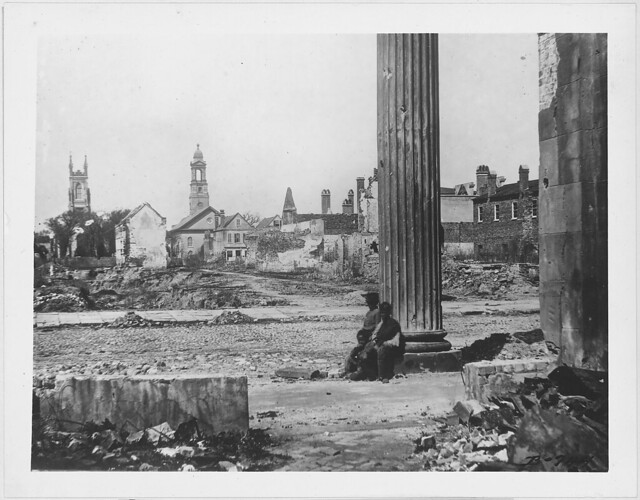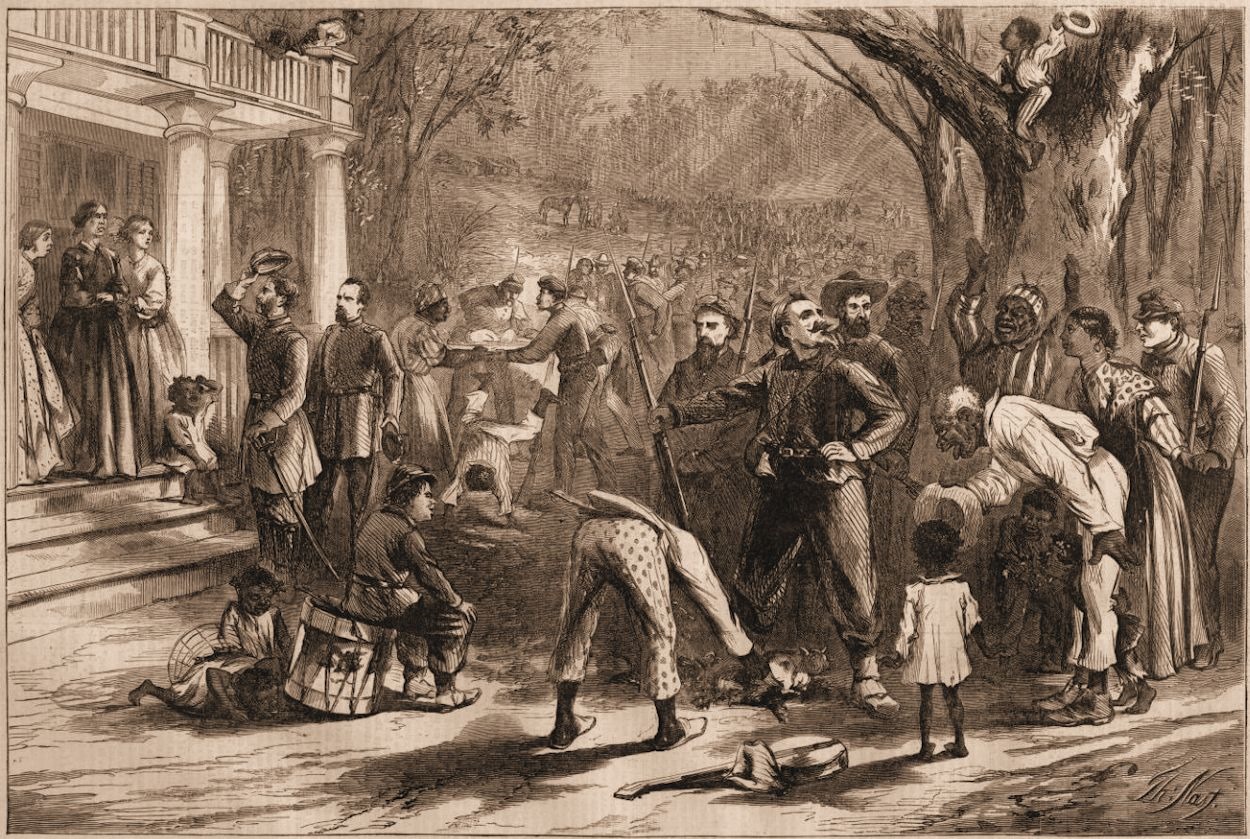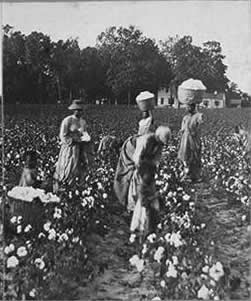
As reviewed in the Wall Street Journal, "Uprooting the Plantations: Launched to preserve slavery, the Civil War destroyed it more quickly than the natural course of events would have," by Edward Kosner, on 18 January 2013 -- The slave-holding American South was a plutocracy built on a monstrosity.
A self-perpetuating elite that derived both its material worth and self-worth from its dominion over millions of stolen Africans, the planters conned themselves into believing that their flogged chattels were devoted to their benevolent masters and that their "peculiar institution" would survive any Yankee challenge. Slaves, proclaimed South Carolina planter James Henry Hammond in 1858, were "happy, content . . . and utterly incapable, from intellectual weakness, ever to give us any trouble by their aspirations."
Three years later, most of the slave states rebelled, the newborn Confederacy fired on Fort Sumter, igniting the Civil War, and their charmed dystopia was doomed.

Fall of the House of Dixie; By Bruce Levine
In his accomplished new book, Bruce Levine, a history professor at the University of Illinois, tells the story of the Civil War's inexorable destruction of slavery and the social order it sustained. An absorbing social history, "The Fall of the House of Dixie" is at its best when it is teasing out what Marxists like to call the "fatal contradictions" of Southern society. Karl Marx himself has a cameo with an astute analysis of Lincoln: The president, he observed, "never ventures a step before the tide of circumstances and the general call of public opinion forbid further delay."
Indeed, for readers whose Civil War bibliography runs to standard works by Bruce Catton and James McPherson—with an audio-visual assist from Steven Spielberg's "Lincoln"—Mr. Levine's book offers fresh insights into the complex reality of what most Northerners thought of as the solid South and the slow evolution of the Union crusade against slavery.
The scope of slavery at its crest in the decade before Fort Sumter was as vast as it was appalling. In 1858, writes Mr. Levine, there were nearly 60,000 Americans who owned at least 20 slaves. Three thousand men owned 100 or more, and one Georgia planter boasted 1,500 human chattels spread over several properties. In all, there were four million slaves in the states that would form the Confederacy and elsewhere in the Union and its territories. They were valued at the equivalent of $83 billion in today's dollars. The cotton they raised represented fully half of the exports of the young republic, mostly to Britain's "dark satanic mills."
The power of the slave interests was as much political as it was economic. Of the 15 presidents before Lincoln, all but three—the two Adamses and William Henry Harrison, who died after just a month in office—were slave owners or their enablers. Across the South, planters dominated state houses, local governments and congressional delegations.
But the grip of slavery on the slave holders went beyond economic and political power. The slave system, Mr. Levine writes, was "the unique basis of the particular outlook, assumptions, norms, habits and relationships to which masters as a social class had become deeply and reflexively attached. It defined their privileges and shaped their culture, their religion and even their personalities." The men of the South came from "a master race," proclaimed Georgia's Gov. George Fitzhugh in 1861. And many used their power, most conspicuously, to exercise sexual mastery over the slave women on their plantations.

From the beginning of the rebellion, slave interests called the shots. Of the 50 delegates from the deep South who met in Montgomery, Ala., in February 1861 to explore secession, 49 were slave owners, 21 of them planters. The millions of Southerners from the hill country and the border states who couldn't afford slave labor or had no need for it on their hardscrabble farms were unrepresented. This fundamental conflict of interest would undermine the Southern cause, shape the destiny of the rebel army and ultimately contribute as much to the fall of Dixie as Lincoln's blue host.
None of this was clear to most people at the start of the war. Southern aristocrats were certain that their slaves would stand with them and that their martial young men would obliterate the ragtag Northern armies poised on their borders—in a month or two at most. Initially, Lincoln's aim was simply to restore the union and bar the further spread of slavery. He was so concerned to keep slave-holding Kentucky in the Union as a base to attack the upper South that he muffled any talk of abolition.
A few knew better. The most prescient was Frederick Douglass, the vibrant ex-slave turned abolitionist orator. "The Negro is the key of the situation—the pivot upon which the whole rebellion turns," he said in 1861. "The inexorable logic of events," he predicted, would drive Lincoln to make the eradication of slavery the spear point of the war.
That is indeed what happened. Early Confederate victories at Bull Run in 1861 and 1862 and elsewhere forced Lincoln's hand. First, slaves were declared "contraband of war"—not freed but ruled to be enemy property eligible for seizure by Union forces. By July 1862, Congress had ordered that slaves of rebel owners "shall be deemed captives of war and shall be forever free." The president himself declared: "We must free the slaves or be ourselves subdued." Six months later, Union troops handed out a million copies of the Emancipation Proclamation throughout the South as thousands of blacks abandoned their masters and fled to the Union columns.
Helpless in the grip of their own self-delusion, the slave owners undermined their own cause. Even as their armies bent under fierce Union attack, they refused to lend their slaves to build defenses or toil behind the lines. Instead, they "refugeed" tens of thousands across the Mississippi to Texas, out of easy reach of Union forces. They allowed planters' sons to buy their way out of serving and resisted desperate measures by Jefferson Davis's government to raise food and other supplies from the plantations. To the end, they refused to give guns to their slaves and press them into combat, even after Lincoln armed the freed slaves and other blacks and formed them into effective regiments.
These actions only aggravated the class conflict between the slavocracy and the poor whites, who realized that they were fighting and dying to preserve the wealth and social order of the haughty rich. One man in the ditches of Georgia wrote that his comrades were "tired of fighting for this negro aristockracy [sic]." Another said: "I would not give my life for all the Blame negroes in the Confederacy." As the rebellion spiraled down, they fled the ranks. Some formed guerrilla bands and fought their ex-comrades. A plantation mistress confided to her diary, "we have almost as much to dread from our own demoralized mob as from the public enemy."
By the end of the war, a third to a half of the Confederate army had deserted, and more than 300,000 Southern whites were fighting for the Union. In Montgomery, the planters and their ladies danced on the lip of the volcano. "We eat, drink, laugh, dance in lightness of heart," one woman reported. A few months later, Robert E. Lee surrendered what remained of his Army of Northern Virginia to Ulysses S. Grant at Appomattox.

Mr. Levine calls the transformation of the South through the abolition of slavery "the second American revolution." It was, of course, incomplete. The impulse to give the freedmen confiscated plantation land so that they could establish economic independence to match their new liberty never got traction. Instead, slavery was replaced by serfdom in the guise of tenant farming that bound the ex-slaves to the land nearly as tightly as the master's chains. Within a generation, the remnants of the Southern white aristocracy found common cause with their poor white brethren to subjugate the blacks once more through Jim Crow laws that thwarted the newly liberated. It would take the better part of another century of struggle to make fresh progress in redeeming Lincoln's original promise.
An accomplished ironist, Mr. Levine recognizes how the South defeated itself more effectively than the zeal and industrial might of the Union. "A war launched to preserve slavery," he writes, "succeeded instead in abolishing that institution more rapidly and radically than would have occurred otherwise." Or, as South Carolina plantation mistress Mary Chesnut lamented: "Our world has gone to destruction." [source: The Wall Street Journal —Mr. Kosner is the former editor of Newsweek, New York, Esquire and the New York Daily News.]
Bruce Levine, the author of "The Fall of the House of Dixie: The Civil War and the Social Revolution That Transformed the South" to our Union Theater for a discussion about his latest work.




Hi there! Do you use Twitter? I'd like to follow you if that would be okay. I'm definitely enjoying your blog and look forward to new updates.
ReplyDeleteMy page ... recommended reading
Happy to found this blog. I have some facts related to this blog and I would like to share with all its readers. Definitely it is going to help everyone and aware people with some more knowledgeable points.bioresonantie zoetermeer
ReplyDeletedriver talent crack
ReplyDeletecoolutils total pdf converter crack
iclone pro crack
avinci resolve studio crack
paragon ntfs crack
goldwave crack
pixologic zbrush crack
vsdc video editor pro crack
ummy video downloader crack
stellar data-recovery iphone crack